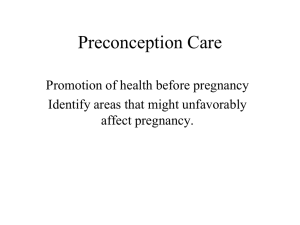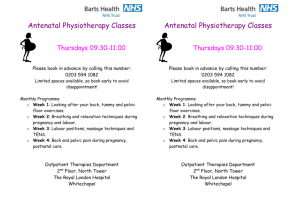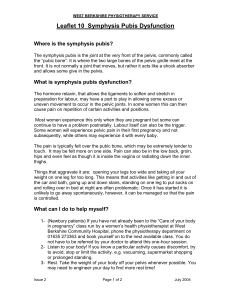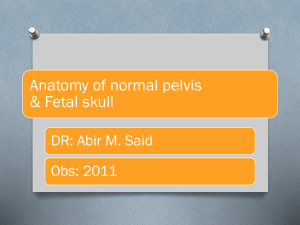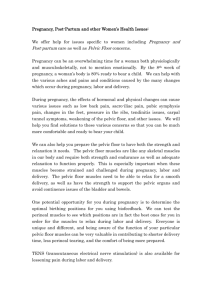Assessing Fetal & Maternal Health
advertisement
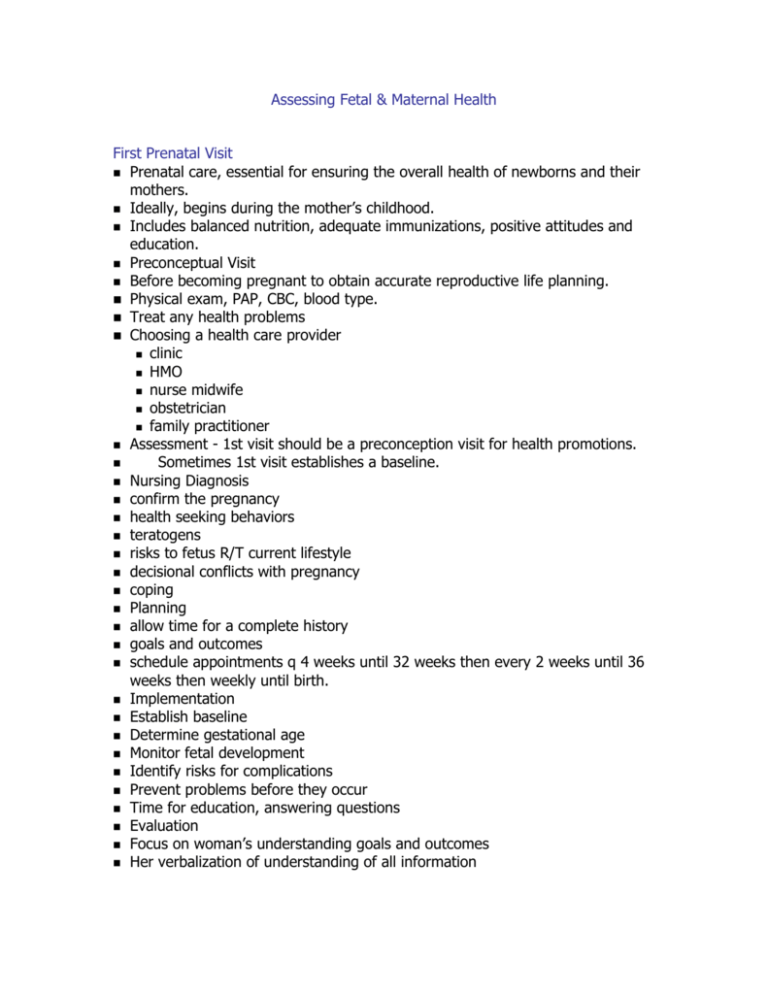
Assessing Fetal & Maternal Health First Prenatal Visit Prenatal care, essential for ensuring the overall health of newborns and their mothers. Ideally, begins during the mother’s childhood. Includes balanced nutrition, adequate immunizations, positive attitudes and education. Preconceptual Visit Before becoming pregnant to obtain accurate reproductive life planning. Physical exam, PAP, CBC, blood type. Treat any health problems Choosing a health care provider clinic HMO nurse midwife obstetrician family practitioner Assessment - 1st visit should be a preconception visit for health promotions. Sometimes 1st visit establishes a baseline. Nursing Diagnosis confirm the pregnancy health seeking behaviors teratogens risks to fetus R/T current lifestyle decisional conflicts with pregnancy coping Planning allow time for a complete history goals and outcomes schedule appointments q 4 weeks until 32 weeks then every 2 weeks until 36 weeks then weekly until birth. Implementation Establish baseline Determine gestational age Monitor fetal development Identify risks for complications Prevent problems before they occur Time for education, answering questions Evaluation Focus on woman’s understanding goals and outcomes Her verbalization of understanding of all information Major causes of death during pregnancy today are ectopic pregnancy, hypertension, hemorrhage, embolism, infection, anesthesia related complications First visit includes: Extensive health history Complete physical including pelvic exam, blood and urine specimens, pelvic measurements and education. Interview provide privacy when scheduling the appointment caution the woman that it may be a long session establish your role provide face to face interview Components of Health History: Establish rapport Gain data on physical and psychosocial health Obtain basis for anticipatory guidance for the pregnancy Demographic data Chief concerns Family profile History of past illnesses History of family illnesses Day history/social profile Gynecologic history Obstetric history Review of systems Conclusion Support Person’s Role: Partners, children, best friends come to prenatal visits. Also allow time for privacy at each visit. Physical Examination: woman should undress, put on a patient gown, and empty her bladder. Physical Examination Obtain urine specimen (clean catch) bacteriuria, protein, glucose, ketones VS, height, weight baseline Assessment of systems: general appearance and mental status head and scalp eyes nose ears sinuses Assessment of systems mouth, teeth and throat neck lymph nodes breasts heart lungs back rectum extremities and skin Measurement of Fundal Height/FH Palpate the fundus at 12 weeks measure the fundal height plot on graph auscultate fetal heart with doppler at 10 to 12 weeks palpate fetal outline at 28th week Pelvic Examination: reveals health information on internal and external reproductive organs. Equipment - speculum, spatula for cervical Pelvic Examination scrapings, glass slide for PAP, culture tube, gloves, lubricant, 2-3 cotton tipped applicators, light and stool. Support is needed during this exam External Genitalia Check for signs of infection, inflammation, irritation, redness, ulceration, discharge or herpes. Check Skene and Bartholin glands for infection. Check for rectocele or cystocele. Internal Genitalia Cervix - purple if pregnant, check for lesions, ulcerations, or discharge. Nulligravida - a woman who is not or never has been pregnant. Cervical os is round and small. In a woman with previous pregnancy the os will be more slitlike. Pap Smear Sample from cervical os and vaginal pool. Vaginal Inspection Culture for gonorrhea, chlamydia or group B strep Dark blue to purple color. Examination of Pelvic Organs Bimanual exam to assess position, contour, consistency and tenderness of pelvic organs. Palpate uterus, ovaries and check Hegar’s sign. Rectovaginal Examination Assess strength and irregularity of posterior vaginal wall. Estimating Pelvic Size pelvic adequacy estimated by week 24 if this is the 1st birth Types of pelves Android - male pelvis, the pubic arch forms an acute angle, making the lower dimensions of the pelvis extremely narrow. Anthropoid - ape like pelvis, the transverse diameter is narrow and the anteroposterior diameter of the inlet is larger than normal. Gynecoid - normal female pelvis, inlet is well rounded forward and backward, the pubic arch is wide. Ideal for childbirth. Platypelloid - flattened pelvis, inlet is an oval, smoothly curved, but the anteroposterior diameter is shallow. A fetal head might not be able to rotate to match the curves of the cavity. Diagonal conjugate - distance between anterior surface of sacral prominence and anterior surface of inferior margin of symphysis pubis. Most useful measurement for estimation of pelvic size. Anteroposterior diameter of the pelvic inlet. Sacral prominence to symphysis pubis. Pelvimeter If measurement is more than 12.5 cm it is adequate (average is 9 cm in diameter). True conjugate or conjugate vera- measurement between the anterior surface of sacral prominence and the posterior surface of the inferior margin of the symphysis pubis. This is an estimated from the diagonal conjugate. Depth of the symphysis pubis (1.2 to 2 cm) is subtracted from the diagonal conjugate measurement. The distance remaining will be the true conjugate or the actual diameter of the pelvic inlet through which the fetal head must pass. Average is 12.5 cm minus 1.5 or 2 cm, or 10.5 to 11 cm. Pelvic Examination Ischial tuberosity - measures is the distance between the ischial tuberosities, or the transverse diameter of the outlet. The narrowest diameter at that level. Medial and lowermost aspect of the ischial tuberosities at the level of the anus. Pelvimeter or ruler is used. 11 cm is adequate because it will allow the widest part of the fetal head, or 9 cm, pass freely through the outlet. Laboratory Assessment Blood studies CBC, H&H and red cell index (anemia), platelet count, sickle cell trait, glucose6-phosphate dehydrogenase. VDRL or RPR Blood typing (include Rh factor) AFP at 16 to 18 weeks Indirect Coombs’ test (Rh antibodies) repeat at 28 weeks. Antibody titers for rubella and hepatitis Repeat at 36 weeks Antibodies for varicella Obtain consent for HIV screening (ELISA) Western blot (Can start AZT). 50-g oral 1-hour glucose loading or tolerance test to R/O diabetes if she has a previous history or symptoms of diabetes. Urinalysis test for albuminuria, glycosuria and pyuria. Tuberculosis Screening PPD (purified protein derivative) tuberculin test to screen for tuberculosis. Positive requires a chest X-ray Ultrasonography Confirms pregnancy length or document healthy fetal growth. Risk Assessment
